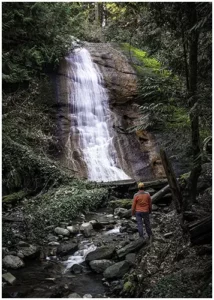
The Charming Northfield Falls in the Heart of Beach Estate Park
Looking to kill off an hour while in Nanaimo, BC? Just a short hop-skip and
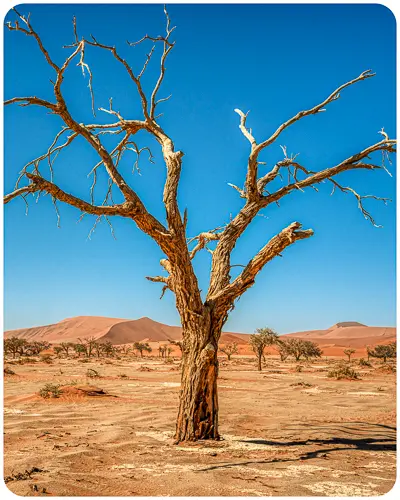

Deadvlei is a dried-up clay pan located near Sesriem in central Namibia, known for its ancient camel thorn trees that died around 600-700 years ago and still stand as black skeletons. The pan was formed when the Tsauchab River flooded, creating temporary shallow pools that allowed the trees to grow. However, when the climate changed, drought hit the area and the sand dunes encroached on the pan, blocking the river from reaching it. Deadvlei’s significance comes from its old trees that were preserved by the dry weather, creating a beautiful contrast with the big orange sand dunes.
Deadvlei is a fascinating and otherworldly landscape located in the Namib-Naukluft National Park of Namibia. Its history is deeply rooted in the geological and environmental transformations that have taken place over thousands of years.
The word “Deadvlei” translates to “dead marsh” or “dead valley” in English, and it accurately describes the barren and desolate nature of the area. Deadvlei was formed 900 years ago when the Tsauchab River flooded and made the Sossusvlei area wet. At that time, the river nourished the Acacia trees that thrived in the region.
The river changed course and Deadvlei was left without water. The absence of water, combined with the harsh desert conditions and intense sunlight, led to the desiccation and death of the Acacia trees.
The desiccation process, combined with the scarcity of decomposing organisms in the arid environment, has preserved the trees remarkably well. Dry weather stops wood decaying and the sun and low humidity slow it down, which preserves tree trunks.
Deadvlei has become an iconic scenic destination, attracting photographers and travelers from around the world who are captivated by its surreal and haunting beauty. The colours of the clay pan, dunes, and trees create a beautiful and powerful sight that shows the strength of nature and time.
Over the years, Deadvlei has become a symbol of Namibia’s natural wonders and is recognized as one of the country’s most iconic and photographed landscapes. It serves as a reminder of the impermanence of life and the ability of nature to create awe-inspiring and dramatic scenes.
Preserving the fragile ecosystem of Deadvlei is of utmost importance, and regulations are in place to protect the area from excessive human impact. Visitors are encouraged to appreciate the beauty of Deadvlei while treading lightly and respecting the natural environment.
In conclusion, the history of Deadvlei is a tale of ecological changes, shifting landscapes, and the enduring legacy of ancient Acacia trees. It stands as a remarkable testament to the forces of nature and the passage of time in our world.
Deadvlei is located in the Namib-Naukluft National Park in the Namib Desert of Namibia. It is a dried-up clay pan surrounded by sand dunes and is nearby the salt pan of Sossusvlei. The area is known for its 900-year-old trees that have become majestic fossils due to the extremely dry climate. Deadvlei is a popular destination for photographers due to its remote location and unique landscape.
To capture the ancient trees of Deadvlei in Namibia, it is important to take into account the weather conditions. The best time of day to photograph is in the morning or late afternoon when the lighting is better and the colours are more vivid. It is important to prepare for sandstorms by wearing protective clothing such as long sleeves and a hat and bringing plenty of water. To take better photos, check the location for good lighting beforehand. Wait for the sun to rise over the sand dunes to get a nice orange colour. Take advantage of weather conditions for photography. Experiment with angles and perspectives during sandstorms or capture the contrast between dark trees and bright sand during midday sun.
Deadvlei is a must-visit destination for any photographer, especially those who are fascinated by the unique beauty of ancient trees surrounded by desert sand. The best time to capture the unique lighting conditions and shadows of Deadvlei is during the morning hours when the sun is still low in the sky. You can play with shadows of trees and dunes to capture contrasting colours and long morning shadows. To achieve the desired effect, keep the sun at your back while taking pictures and try to capture the trees in the landscape. Scout the area beforehand to find the best lighting for your shots. Bring different lenses, such as a wide-angle and medium telephoto lens, and a strong tripod. Don’t forget to wear lightweight shoes, carry plenty of water, and protect yourself from the sun with a brim hat and sunscreen.
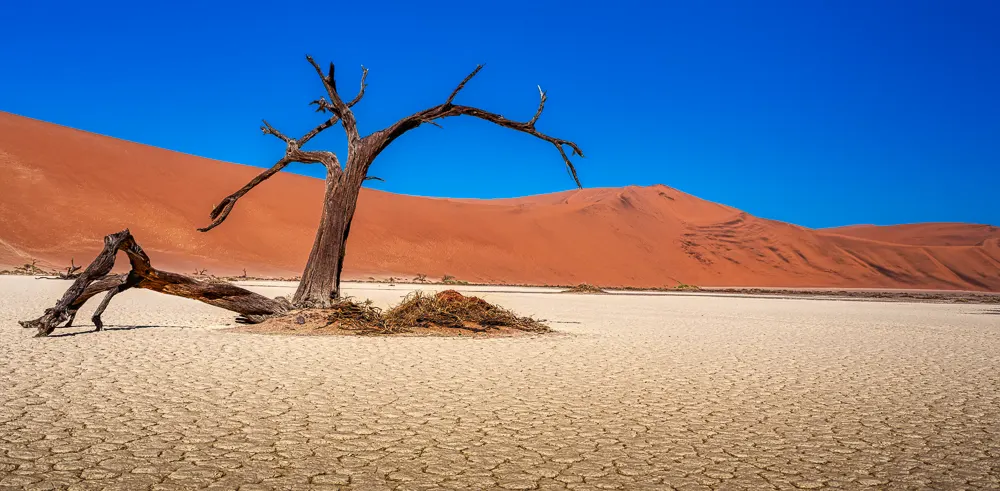
Having a range of lenses such as a wide-angle and medium telephoto lens is crucial for capturing breathtaking photos of the ancient trees in Deadvlei. A sturdy tripod is also necessary to stabilize your camera. Infrared photography could be good there, but missing the glow of the orange light on the sand would be a shame. Lightweight shoes, a brim hat, sunscreen or lightweight long sleeves and long pants are recommended for clothing. As the area is extremely dry, it is important to bring plenty of water. The sand dunes can be challenging to navigate, so a 4×4 vehicle is recommended to get to the parking lot for the walk into Deadvlei. Finally, it is essential to scout the scene before the best light and look for patterns in Deadvlei for your composition.
To capture the perfect shot of the ancient trees in Deadvlei, it’s important to understand sun exposure. Arrive early in the morning or late in the afternoon to avoid harsh midday sun and take advantage of the golden hour. Play with the shadows of the trees and dunes and keep the sun at your back as much as possible while taking pictures. Use polarizing filters to reduce glare and enhance contrast.
To capture the perfect shade shot of the ancient trees of Deadvlei, timing, lighting, and composition are key. The morning is the best time to capture the long shadows of the trees and dunes. Position yourself with the sun at your back to avoid harsh shadows and capture the trees in the landscape. Play around with the framing and use shadows to add depth and contrast to the shot. Look for patterns and structures in the landscape and incorporate them in your composition. Experiment with different angles and shoot into the sun for a creative twist. Remember, simplicity is key with only four elements to work with: orange dunes, white clay pan, black trees, and an electric blue sky.
To capture the perfect photograph of the ancient trees in Deadvlei, mastering the lighting conditions is crucial. This allows for more depth and contrast in the image. When working with the harsh desert sun, it’s important to look for shade or use it to your advantage by incorporating shadows into the composition. Adjusting your camera settings is also important for optimal results. Using a low aperture like f/2.8 or f/4 can create a shallow depth of field and isolate the subject. A fast shutter speed like 1/1600 sec can freeze motion and prevent blur. Lastly, composition is key. Look for patterns, shapes, and unique angles to make your photograph stand out.
Deadvlei has a unique and unusual landscape, which allows photographers to take stunning pictures of old trees on a dry white clay ground. When photographing the trees, it is important to consider the framing, composition, and lighting to create a visually compelling image. To frame the trees, consider using a wide-angle lens to capture the vastness of the landscape and to include the surrounding dunes in the shot. When composing the image, try to create a sense of depth by placing the trees in the foreground and including the distant dunes in the background.
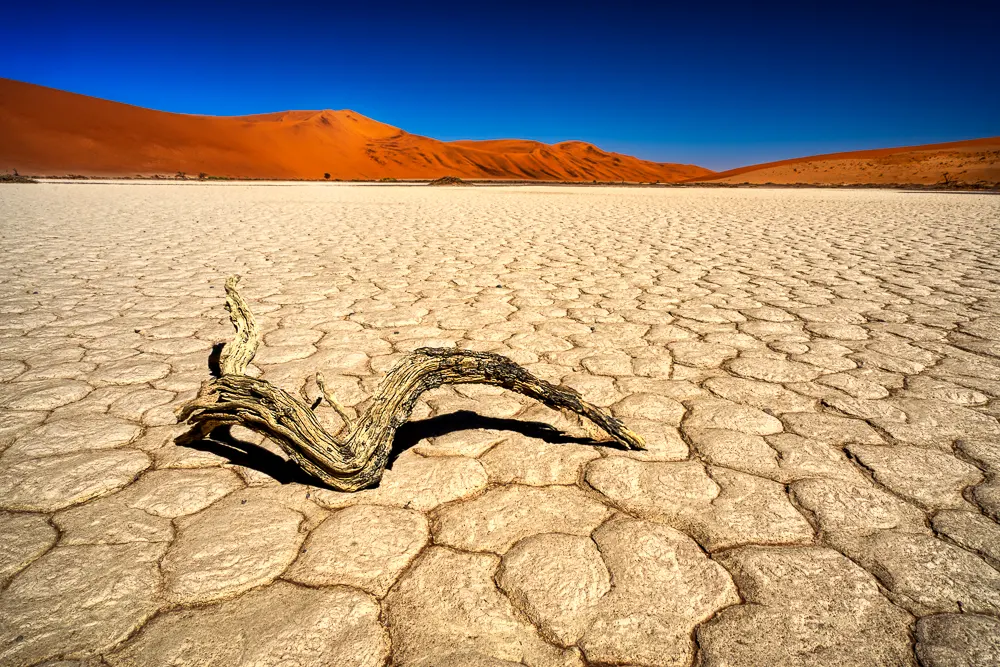
Achieving the essence of Deadvlei in your photographs is all about highlighting the stunning contrast between the red sand dunes and white clay pan. This contrast creates a truly remarkable visual impact. The starkness of the landscape, with the ancient trees preserved for centuries, adds a sense of timelessness to your images.
When framing the trees in your compositions, look for interesting textures, shapes, and patterns that add depth and complexity to your images. Use different lenses and focal lengths to show different moods and perspectives. For example, a wide-angle lens to capture a wider view of the landscape or a telephoto lens to focus and show details of the trees.
Timing is also crucial, as the trees’ shadows can add another layer of interest to your images. Shooting early or late in the day can also create a warm, golden light that enhances the colours and textures of the landscape. With these tips in mind, you can effectively capture the unique beauty of Deadvlei in your photographs.
Deadvlei’s vibrant colours make it a photographer’s paradise. The bright orange dunes, contrasting with the white clay pan and black trees, create a unique colour palette that can be enhanced with the right techniques. Shooting during the golden hour, either early in the morning or late in the afternoon, can help bring out the warm tones of the landscape. Experimenting with different angles and compositions can add depth and interest to your photos. Consider using a wide-angle lens to capture the vastness of the landscape and a polarizing filter to reduce glare and enhance colours. Finally, adjust your camera settings to achieve the desired exposure and focus on the details of the trees and patterns in the clay pan. With these tips, you can capture the vibrant colours and natural beauty of Deadvlei in your photographs.
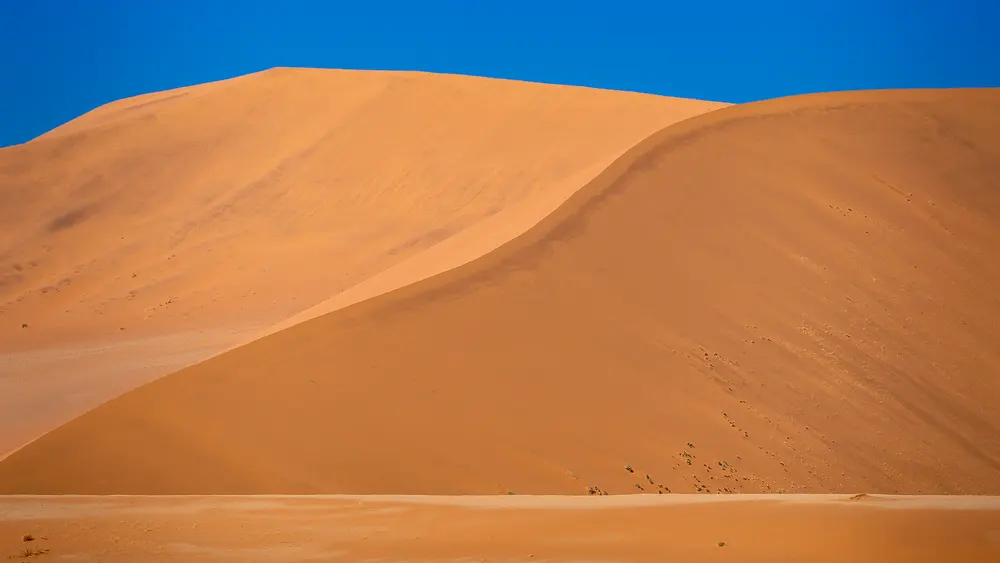
To capture the intricate textures of the ancient trees in Deadvlei, it is essential to pay attention to lighting and angles. The contrast between the rough textures of the trees and the smooth sand dunes surrounding them can be highlighted by shooting from a low angle. This will also emphasize the unique patterns and details of the bark. Using a medium telephoto lens can help in isolating specific details of the trees for a more focused composition. Experimenting with black and white photography can also bring out the textures and patterns in a more striking way. Using a tripod and bracketing shots can help in capturing the details in different exposures.
When photographing the ancient trees of Deadvlei, it is important to pay attention to the direction of the light. The best time to capture this is early in the morning when the sun is low in the sky. This not only provides interesting shadows, but also helps to create depth and texture in the images.
To effectively capture the light direction, it is recommended to arrive at Deadvlei early to avoid crowds and harsh lighting. Look for interesting patterns and structures in the trees, such as groups of trees or single trees with unique shapes. Incorporating the trees’ shadows can also add an interesting element to the composition.
When setting up the shot, consider using a wide angle lens to capture the vastness of the landscape and the towering trees. Experiment with different aperture settings to achieve the desired depth of field and highlight the sun’s sparkle. It is also important to pay attention to the exposure settings to avoid unnecessary noise or blur in the image.
Overall, capturing the light direction in Deadvlei requires patience, creativity, and attention to detail. Beginner and intermediate photographers can take great pictures of the ancient landscape by following these tips and practicing.
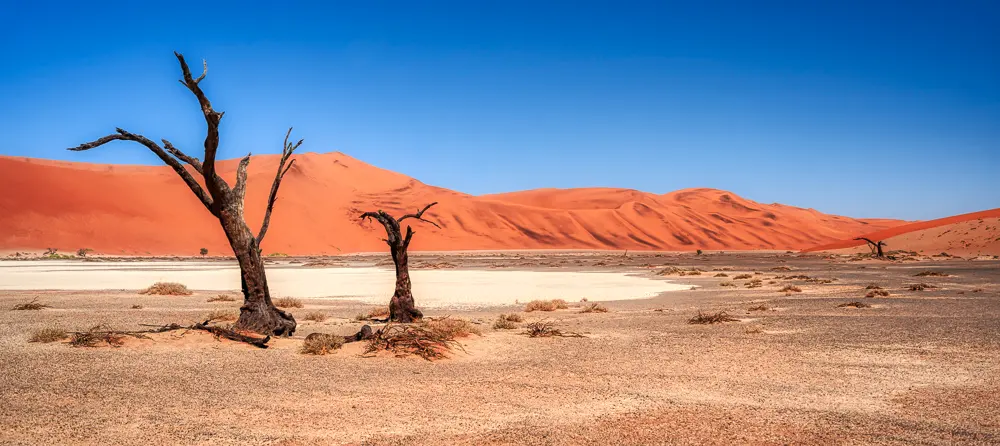
When capturing the ancient trees of Deadvlei, a telephoto lens can come in handy. It allows for capturing distant trees and compressing the perspective, creating a stunning effect. The focal length of the lens should be selected based on the desired composition, but a range between 150-300mm is recommended. Adjusting the aperture to f/5.6 or wider can create a shallow depth of field, isolating the subject and blurring the background. Shutter speed should be set at 1/60 sec or higher to avoid camera shake and capture sharp images. Positioning is key, and finding a tree that is not in direct sunlight can add contrast and depth to the image. Using a tripod and lens hood is also recommended.
To capture the ancient trees of Deadvlei in detail, it’s important to approach them from different angles and distances. Look for interesting patterns and shapes created by the branches and try to incorporate them into your composition. Get close to the trees for details and incorporate the surrounding landscape for context and contrast. Experiment with different camera settings to achieve the desired depth and contrast, and consider using shadows to add drama to the photos. Remember to be patient and take your time to find the perfect shot.
Using a tripod is crucial to ensure stability and sharpness. Look for a sturdy tripod that can support the weight of your camera and lens. A tripod with adjustable legs and a center column will allow you to adjust the height and angle of your camera for different compositions. When setting up your tripod, make sure it is on stable ground and avoid placing it on sand or unstable surfaces. Use a remote shutter or self-timer to avoid camera shake when taking the shot.
When photographing Deadvlei’s ancient trees, choosing the right aperture is crucial. A low aperture like f/2.8 creates a shallow depth of field, focusing on the subject while blending the foreground and background. However, for capturing the entire scene, a higher aperture like f/14 may be more suitable. Experiment with different apertures to find the right balance between depth of field and clarity.
Don’t be afraid to take multiple shots and try different framing and perspectives, including shooting into the sun or incorporating the trees’ shadows. Keep your camera settings basic and avoid unnecessary noise/blur to focus on composition and creativity.
To capture the ancient trees of Deadvlei with a dreamy effect, use a wide aperture such as f/2.8 or wider. This will create a shallow depth of field, blurring the foreground and background and drawing the viewer’s attention to the trees. This effect can enhance the overall mood of the photograph, creating a sense of mystery and otherworldliness. Experiment with different focal lengths to find the right composition, and consider using a tripod to ensure sharpness. Don’t be afraid to play with different aperture settings to achieve your desired effect.
One of the things I like to do is position myself with my back to the sun. This usually enhances the natural light and helps you capture the full expanse of the landscape. Be aware that the sun rises quickly, so it’s important to arrive early to avoid harsh light and crowds. Additionally, try playing with the shadows and contrasting colours of the dunes and trees to create unique and visually stunning compositions.
To photograph the old trees of Deadvlei with their distinct environment, it’s crucial to position them against the white clay pan that creates contrast. Use the surrounding sand dunes to create depth and visual interest in your photographs, playing around with the sunlight and the framing. The best times of day to capture the landscape are during sunrise and sunset, avoiding midday when the colours of the dunes fade away. Look for patterns and compositions in Deadvlei, incorporating the shadows of the trees and the movement of the dunes. With these tips, you can take advantage of the surrounding landscape and capture the beauty of Deadvlei in your photographs.
When photographing the ancient trees of Deadvlei, it’s important to experiment with different camera settings to capture the beauty of the location. Try using a wide aperture such as f/2.8 to create a shallow depth of field and draw attention to the subject. Shutter speed can be adjusted to freeze motion or create motion blur, depending on the desired effect. ISO should be kept low to minimize noise, but can be increased if necessary in low light situations. White balance can be adjusted to create a warm or cool tone to the image. Use different lenses, such as a telephoto and a wide angle, to capture great photos with a varied compositions without overexposing the bright blue sky. Don’t be afraid to experiment and take creative risks to capture the beauty of Deadvlei.
When capturing the ancient trees of Deadvlei, it’s important to take the time to analyze each image and make adjustments as needed. Here are some tips to help you get the best results:
Take your time, try different techniques, and make adjustments as necessary. With a little patience and practice, you can capture stunning images of these ancient trees that will leave a lasting impression on your viewers. So, take your time, analyze each image carefully, and make the necessary adjustments to enhance the final result. Happy shooting!
When photographing Deadvlei, consider using polarizing and neutral density filters. The polarizing filter makes colors brighter and reduces reflections. The neutral density filter increases the time the photo is being taken, creating an interesting effect with moving objects in the picture.
The hike to Deadvlei takes approximately 30 minutes to 1 hour, depending on your pace and fitness level. The trail is relatively flat and straightforward, offering a rewarding journey through the Namib Desert’s unique landscapes..
To capture the best photos of Deadvlei, use polarizing and neutral density filters to enhance colors and textures. Arriving early or late in the day provides unique lighting opportunities. Experiment with angles, compositions, and camera settings while carefully adjusting for optimal exposure.
The dead trees in Namibia are estimated to be over 700 years old, standing as haunting and ancient remnants in locations like Deadvlei.

Looking to kill off an hour while in Nanaimo, BC? Just a short hop-skip and

Photography can be a fulfilling and enjoyable hobby that brings a creative outlet to your

Welcome to our guide to Photoshop tutorials for beginners: A Complete Beginner’s Tutorial for Learning